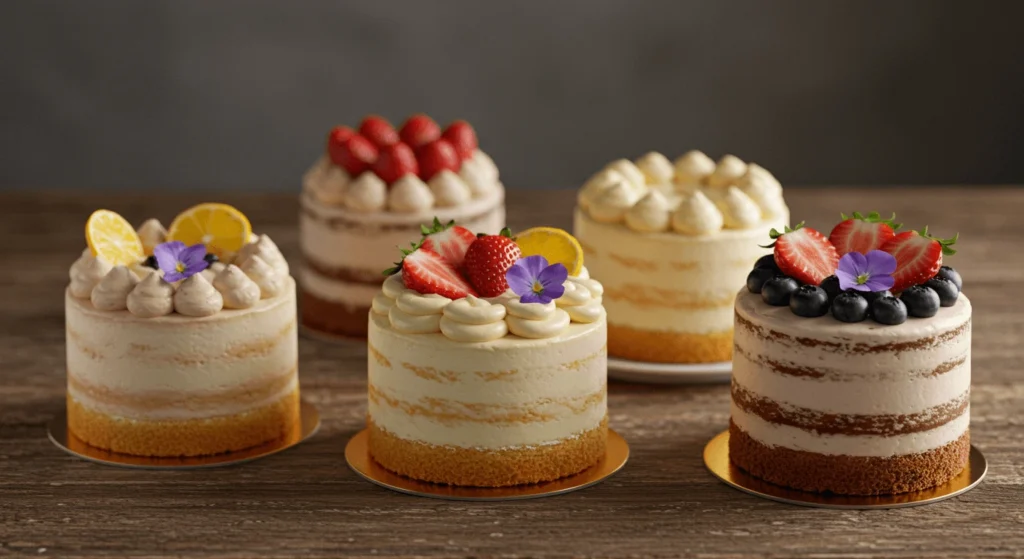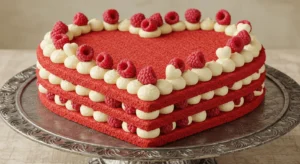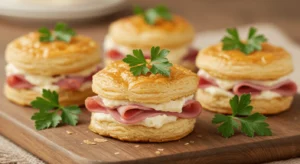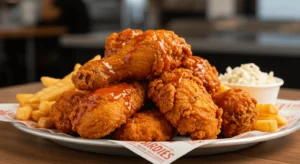Introduction
Mini cakes are delightful, bite-sized desserts perfect for any occasion. They combine flavor, creativity, and elegance in small portions. Whether for a birthday, wedding, or casual gathering, mini cakes offer a unique twist on traditional cakes. Their individual size makes them easy to serve and enjoy. From simple vanilla to rich chocolate, mini cakes can be customized with various flavors and toppings. They are not only visually appealing but also versatile for different themes and events. In this post, we’ll explore how to make the perfect mini cakes, offering simple and delicious recipes to try.
What Are Mini Cakes and Why Are They So Popular?
Defining Mini Cakes vs. Cupcakes
Mini cakes and cupcakes are often confused but are different in structure and style. Mini cakes are small, layered cakes made to resemble full-size cakes in appearance. They are typically sliced and stacked with frosting or filling, giving a refined, elegant look. Cupcakes are baked in liners, usually with a domed top and piped frosting. Cupcakes often have a fluffier texture and are lighter than mini cakes. Mini cakes are more customizable in decoration and are better suited for intricate designs. Their finish is often smooth and polished, like a mini version of a celebration cake.
Mini Cakes for Special Occasions
Mini cakes are perfect for weddings, birthdays, and holidays. They can be decorated individually to match themes or guest preferences. These cakes offer a personalized dessert option without needing to cut slices. Guests enjoy having their own beautifully decorated cake. For weddings, mini cakes can match the main cake or replace it altogether. Birthdays and baby showers often feature themed mini cakes in various flavors. They also photograph well, adding charm to dessert tables. Their elegance and flexibility make them ideal for both formal and casual celebrations.
The Appeal of Bite-Sized Desserts
Mini cakes are loved for their perfect portion size. Each guest gets a full dessert without leftovers or waste. They make serving easier, especially at large events. Bite-sized treats also allow more variety—guests can sample different flavors. Mini cakes are elegant yet manageable, combining taste and convenience. They feel indulgent without being too heavy. Their visual appeal also adds excitement to dessert spreads. For hosts, they offer creative freedom and less mess during serving.
Key Ingredients for Perfect Mini Cakes
Basic Cake Batter Ingredients
The foundation of mini cakes begins with simple ingredients. All-purpose flour gives structure and stability to the cake. Sugar adds sweetness and helps with browning during baking. Eggs bind the ingredients and contribute moisture and richness. Butter or oil provides fat, enhancing the cake’s flavor and tenderness. Baking powder or baking soda is added for leavening, helping the cake rise. Milk or buttermilk is used to moisten the batter and add softness. A pinch of salt balances the sweetness and sharpens the other flavors. These basic ingredients create a smooth, even-textured cake that’s easy to bake and decorate.
Flavor Variations for Mini Cakes
Mini cakes are perfect for experimenting with flavors. Classic vanilla is light, simple, and pairs well with most fillings or frostings. Chocolate mini cakes offer a rich, indulgent taste, ideal for special occasions. Fruit-based flavors like lemon, strawberry, or blueberry add brightness and freshness. Spice cakes with cinnamon or nutmeg provide warmth and depth. You can even try flavors like matcha, caramel, or coconut for a unique twist. Adding flavored extracts or zests enhances each variation. Mixing flavors in one batch gives guests more options to enjoy.
Choosing the Right Frosting
Frosting adds flavor, texture, and beauty to mini cakes. Buttercream is a classic option, smooth and easy to pipe. It comes in endless flavor variations like vanilla, chocolate, or coffee. Cream cheese frosting offers a tangy contrast to sweet cakes, perfect for red velvet or carrot cake. Whipped cream frosting is light, fluffy, and less sweet—great for fruit-flavored cakes. Ganache adds richness with a glossy finish, especially on chocolate cakes. Choose your frosting based on cake flavor and occasion. Consistency matters too—soft for spreading, firm for piping. Good frosting completes the mini cake experience.
Adding Fun Fillings or Toppings
Mini cakes can be filled or topped for added flavor and visual appeal. Popular fillings include fruit preserves, lemon curd, or chocolate ganache. A surprise center adds excitement to each bite. Toppings like fresh berries, citrus zest, or edible flowers make the cakes eye-catching. Chocolate chips, sprinkles, or crushed nuts add texture and crunch. For themed events, you can match toppings to colors or occasions. Drizzles of caramel or fruit syrup elevate the look and taste. Creative fillings and toppings help you personalize your mini cakes for any celebration.
Step-by-Step Guide to Making Mini Cakes
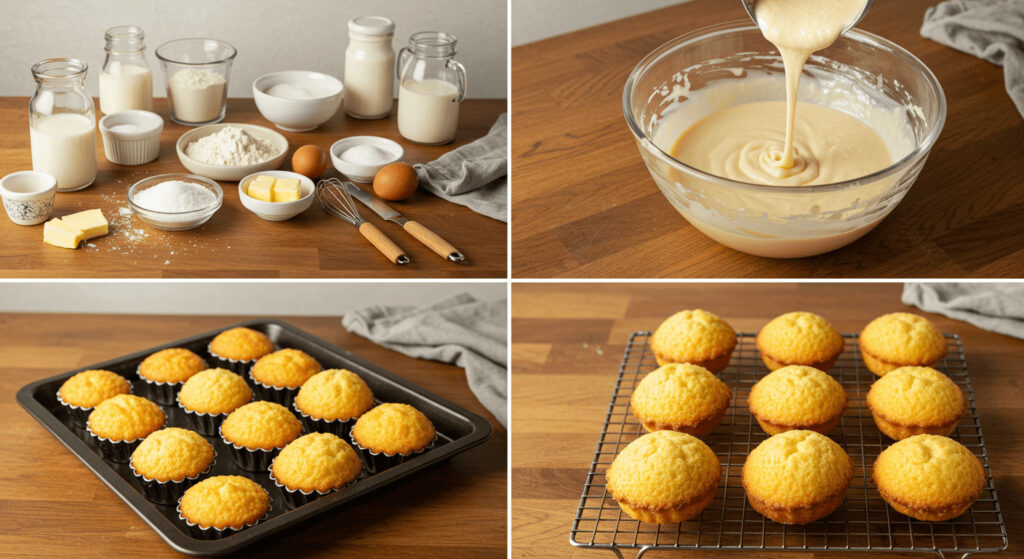
Preparing the Batter
Start by gathering all your ingredients and letting them reach room temperature. Cream the butter and sugar together until the mixture is light and fluffy. Add the eggs one at a time, mixing well after each addition. Slowly mix in the flour and leavening agents, alternating with milk or another liquid. Stir in any flavor extracts or zests last. Be careful not to overmix the batter to keep the texture light. The finished batter should be smooth, thick, and ready to pour into mini cake molds or pans. Grease the molds or line them before filling.
Baking Time and Temperature
Preheat your oven to 160–175°C (325–350°F) depending on your oven type. Fill each mini cake mold about two-thirds full with batter. Bake for 15–22 minutes, depending on size. Check for doneness by inserting a toothpick into the center; it should come out clean. Avoid opening the oven door too early to prevent sinking. Keep an eye on color—golden tops are a good sign. Even baking is key for perfect mini cakes. Use the middle rack for consistent heat.
How to Ensure Perfectly Moist Mini Cakes
Use room temperature ingredients to help the batter blend evenly. Don’t overbake—set a timer and check early. Adding a touch of yogurt, sour cream, or applesauce keeps cakes soft and tender. Avoid overmixing the batter, which can lead to dryness. Make sure to measure ingredients precisely. Use a light hand when folding in dry ingredients. Keep cakes covered after cooling to prevent moisture loss. For extra moisture, lightly brush the cakes with simple syrup before frosting. This works especially well for fruit-flavored or sponge-style mini cakes.
Cooling and Removing the Cakes from the Pan
Once baked, remove the mini cakes from the oven and place the pan on a wire rack. Let them cool in the pan for about 5–10 minutes. Gently run a knife around the edges if needed to loosen. Carefully invert the pan or remove the cakes using a spoon or silicone spatula. Place them on a cooling rack to cool completely before decorating. Letting them cool fully prevents melting or sliding frosting. Always handle the cakes gently to avoid cracking or damaging their shape. Cool, dry cakes are easier to frost and stack if layered.
Creative Ways to Decorate Mini Cakes
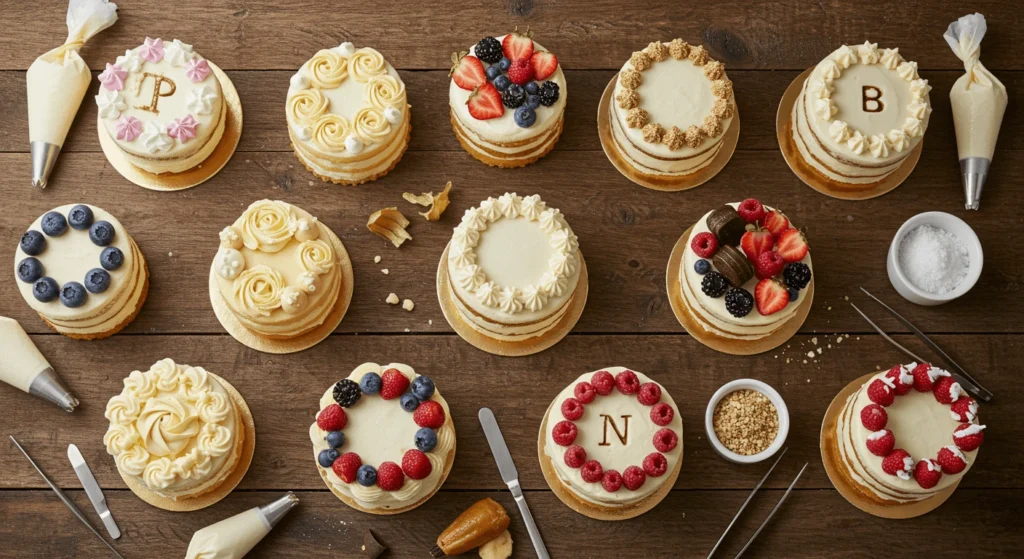
Piping Techniques for Frosting
Use piping bags with different nozzles to create swirls, stars, or rosettes on mini cakes. A round tip gives a smooth dome, while a star tip adds texture and elegance. Practice even pressure when piping to keep decorations clean and uniform. Start from the center or edge depending on the design. You can use colored frosting to create visual contrast. Chill the frosting slightly if it becomes too soft. Use small spatulas or offset tools to smooth edges and clean up details. With simple tools, your cakes can look professionally decorated.
Adding Decorative Elements
Top your mini cakes with edible flowers, fresh fruit slices, or berries for natural beauty. Use sprinkles or chocolate curls for fun and color. Fondant cutouts can add shape and theme-specific designs. Edible gold leaf or shimmer dust adds elegance to formal cakes. Crushed nuts or cookie crumbs provide texture and flavor. For a rustic look, drizzle with caramel or fruit syrup. Keep designs balanced by not overcrowding the top. Let decorations match the flavor and theme. Always use food-safe items, especially with flowers or glitter.
Creating Layered Mini Cakes
To make layered mini cakes, slice each cake horizontally into two or three even layers. Use a serrated knife for clean cuts. Pipe a layer of frosting or filling between each cake layer. Stack the layers gently and align them evenly. Chill briefly to set the layers before adding the top decoration. Use a small offset spatula to apply a smooth outer coat of frosting. You can create a “naked cake” effect by leaving some cake edges exposed. Mini layer cakes look elegant and work well for individual servings at formal events.
Personalized Decorations for Special Events
Personalize mini cakes by adding initials, names, or age numbers with icing or fondant letters. Match frosting colors to party themes like pastel for baby showers or gold for anniversaries. Use themed toppers or edible prints for birthdays and holidays. Wedding mini cakes can feature lace patterns or sugar flowers. Add ribbons, pearls, or custom tags to the base of each cake. Monogrammed mini cakes are perfect for place settings. Individual customization makes guests feel special and adds charm to any celebration. Keep designs consistent for a polished display.
Troubleshooting Common Mini Cake Problems
Cake Falling Apart After Baking
If your cakes fall apart after baking, let them cool in the pan for at least 5–10 minutes. Removing them too early can cause crumbling. Always grease or line the molds properly to prevent sticking. Overbaking can dry out the cake and make it crumbly, so check doneness with a toothpick. Measure ingredients accurately—too little egg or fat can cause a dry, fragile cake. Be gentle when removing the cakes, using a spatula or turning the pan carefully. Allow the cakes to cool completely on a wire rack before frosting or stacking.
Frosting Issues: Too Runny or Too Thick?
If your frosting is too runny, add more powdered sugar one tablespoon at a time to thicken it. Chill it for 10–15 minutes before piping. Too thick? Add a teaspoon of milk or cream gradually until desired consistency is reached. Butter should be softened but not melted before mixing. Overmixing can affect texture, so mix just until smooth. Use a test swirl on a plate before decorating your cakes. The perfect frosting should hold its shape but still spread easily.
Avoiding Overbaking or Undercooking
Bake cakes at the right temperature—typically 160–175°C (325–350°F). Check doneness with a toothpick; it should come out clean. Avoid opening the oven door too early. Rotate pans halfway through baking if needed for even heat. Use the middle oven rack for best results. Mini cakes bake faster than regular cakes, so monitor them closely. Use a timer and set it for the minimum suggested time first. Undercooked cakes will sink in the middle, while overbaked ones become dry and crumbly. Proper baking ensures soft, moist, and perfectly risen mini cakes.
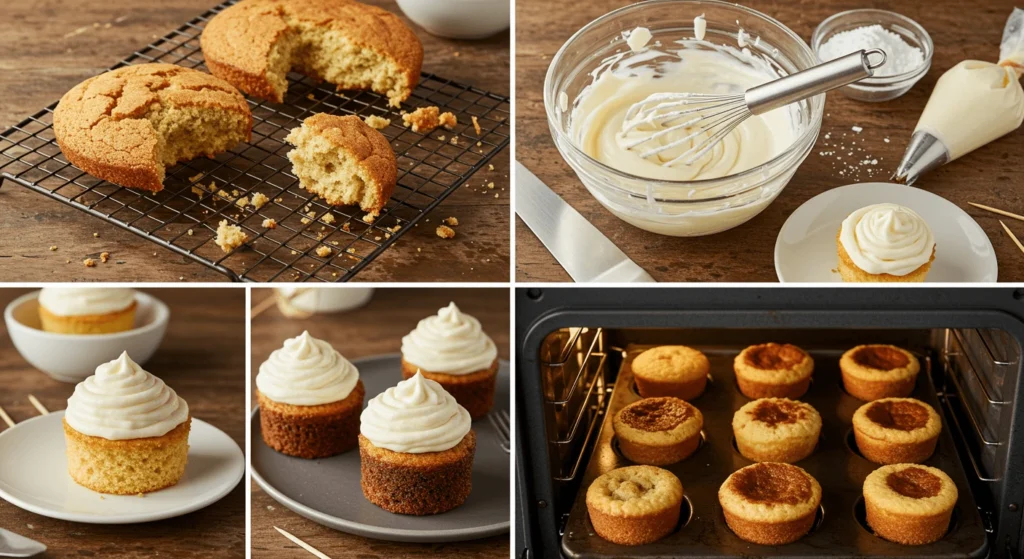
Conclusion
Mini cakes are the perfect blend of charm, flavor, and creativity. Whether you’re baking for a party, a gift, or just because, these bite-sized treats bring big satisfaction. With the right ingredients, techniques, and decorations, anyone can master the art of mini cake making. From batter to frosting and every sprinkle in between, each step offers a chance to express your style and delight your guests.

